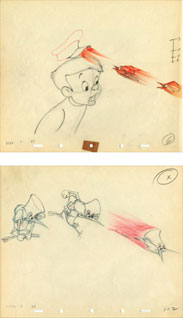41 Pose and Mood Plus Timing and Phrasing and Texture
Poses in a scene accomplish more than just the mood or dramatics: they also create extremes. Animating a scene by extremes (as opposed to animating straight ahead) makes it easier to time the action by use of timing charts. These charts are put on each extreme, making it possible for the follow-up crew to complete the breakdowns and inbetweens according to the animator’s concept. The timing charts are also a record of how the scene was animated, so if any timing changes are necessary they can be made by merely adjusting the charts and then new drawings are made accordingly.
Don Graham in his chapter on reality (from the unpublished Art of Animation) called the extreme “a story-telling drawing,” and that by making this drawing more expressive; the intervening action could be suggested rather than delineated. He also suggested “posed” animation is like watching a hummingbird darting from flower to flower. The rest periods when the bird is hovering in midair or when it is poised with its beak buried in a flower are the poses we have to see. The intervening action can be mere blurs, but the essence of the action will be clear.

Discrimination of course must be used in the use of blurs. Certainly, characters like Taran and Eilonwy (Black Cauldron) are not going to move fast enough to cause blur. But still, in their case, the premise holds true that the extremes are the most important drawings and should be the most expressive. Good, crisp timing will make blurs unnecessary.
Phrasing is another aspect of animating with extremes. People and animals tend to move in idiosyncratic phrases. They move-pose, gesture-pose, anticipate, move-pose, etc. Different species have phrased movements that are peculiar to that species. Speech is delivered in phrases. We say ten words and pause or five words and pause, etc. Some people rattle on until they run out of breath and then pause. John Lounsbery and I once ran a whole picture reel of Peter Pan with just one line of repeating dialog. It was amazing the number of scenes the dialog synced to.
Phrasing, as Eric Larson pointed out in his paper “Getting It on The Screen,” brings an action or an attitude to life, which makes it interesting and believable. Phrasing can also be thought of as a beat or rhythm. All of life has a rhythm: some days are full of staccato beats; others are so slow they seem to contain nothing but long holds. A day can be charted like a scene of animation: there are accents like extremes, moments of decision making like anticipations, and slow-ins and slow-outs.
Some people act and can make their own rhythm, others react and their rhythms are determined by chance. In animation there can be no chance — rhythm must be created consciously.
The pose that best portrays the mood of a scene can be thought of as an extreme–extreme. That drawing will usually be the one taken from the storyboard. It is only natural that one drawing in a scene will be the most extreme. That extreme–extreme should be reserved for the pose that stresses the storytelling aspect of that scene. Usually in a line of dialog one or two words will be emphasized for dramatic impact or to stress their meaning.

Those stressed words suggest to the animator where and how to time the action, which drawing is to be the anticipatory one, the extreme one, or the extreme–extreme one. If several words are spoken closely together, one extreme may take care of them by means of phrasing. There might be thirty words spoken in a scene but only six extreme drawings.
Groups of words that form phrases are chosen, which not only simplifies the animation, but it also makes it easier to emphasize the important words. The dialog might even suggest a different phrasing for the body than the head, or a different one for the head than the mouth. Arms and hands help in phrasing dialog: much can be said with the eyes.
Phrasing and timing can also be thought of as texture. We are used to thinking of texture as the surface quality of cloth or of other materials. Some have an overall design or texture, like the warp and woof of woven cloth, or like a tapestry or Persian rug. Others may have small groupings of texture on a field of plainness. Likewise a scene may have an overall linear pattern (texture), a scene of great and sustained activity taking place, like a hall full of dancing people, or a bleacher full of home team fans during a grand slam home run, or it may have almost no texture, like a lazy summer afternoon scene in the country — the hillbillies from the Martins and Coys are lounging on the hillside. Certainly, the timing of each of these last two scenes would be different. The fans in the bleacher scene would require several violent extreme poses and the idea could be put over in a couple of feet. The hillbilly scene could probably be done with only one tranquil pose and might require several feet to present the idea that nothing is happening.

